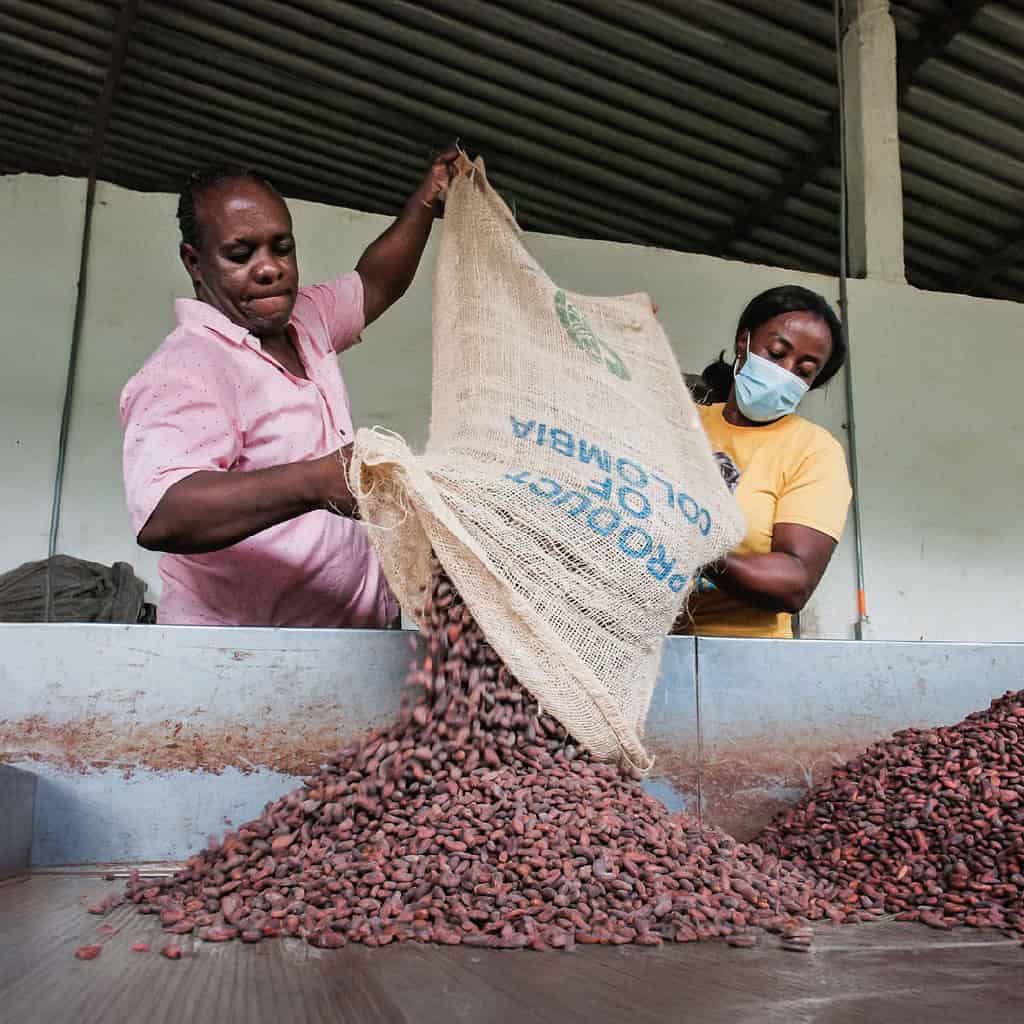CortePaz

Revamping cacao in Colombia
- Case Study
- Sustainable agriculture
- Latin America
- 2024
By the numbers
CortePaz is an association of cacao producers in Colombia that provides technical assistance to smallholder farmers. A combination of strong commercial partnerships and production interventions has made positive economic impact possible.
The problem
Small cacao farmers in the remote region of Tumaco, Colombia produce some of the world’s most delicious cacao beans. The problem is that their yields fall well short of their potential, and their incomes suffer because of it. In an efficient system, farmers would be expected to harvest up to 1,000 kilograms of dried beans per year. Average yields in the Pacific coast of Nariño range between 150-200 kilograms per hectare.
Cacao is a demanding crop. Soil type, precipitation, plant variety, shade availability, and fertilizer type can all dramatically impact yields. In rural Colombia, smallholder farmers face these challenges head-on but they lack the know-how and resources to navigate them: technical assistance is scarce, quality inputs are expensive, and they lack the means to pay for them. Help seems distant too: Government interventions are underfunded and rarely extend to rural communities, while NGO programming lacks long-term sustainability. Even online learning is unreliable due to spotty cell phone access.
The solution
CortePaz has developed a fit for purpose, scalable, and financially sustainable technical assistance service designed to increase productivity and quality of cacao farmers’ crops. The company creates a tailored work plan for each farm and then provides the necessary labor and inputs for the revamp. The service is offered as an “embedded micro credit facility” where all upfront costs are covered by CortePaz and the farmer makes in-kind payments to the association in the form of high-quality cacao at the end of the season.
The origin
The Corporación Técnica para el Desarrollo del Pacífico (“CortePaz” or “The Association”), founded in 2014 by Gustavo Mindineros and Ruben Lasso, aims to improve the productive development of the predominantly Afro-Indigenous community in the Tumaco region of Colombia.
The impact
The Association works with over 150 smallholder families on a monthly basis. While impact will be gradual, in the long-term the initiative will enable farmers to increase their cacao productivity over 4x compared to their current production. When combined with improvement in the quality of their cacao harvest, smallholders are expected to increase their income by 385%.
Other, longer-term impacts are expected to include improved agricultural education and knowledge, improved engagement from youth and generational handover of cacao production, and reduced production of illicit crops through providing alternative livelihoods.
The story
There is a saying in agriculture: “Getting a good product out of the ground is only 50% of the job. The other half is selling it.” This is a sentiment that CortePaz founder Gustavo Mindineros deeply understood when he conceived of The Association. Recognizing the unmet market demand for their particular cocoa and the potential for increased production, they designed their business model accordingly.
“To guarantee sustainable cacao production and generation of a decent income for families we needed to find a strong commercial partner,” says Gustavo. He needed to ensure that if they were going to invest in production improvements, there would be a market to absorb every bit of that increased production. That market came in the form of another Acumen investee, Cacao de Colombia, who operated a cacao processing facility and was developing a name for themselves as an award-winning chocolate company. “[Cacao de Colombia] wanted us to satisfy a significant percentage of unmet demand…That type of partnership made us feel very, very calm.”
With a commercial alliance in place, Gustavo now had the incentive he needed to improve the production practices of the cooperative’s farmers to meet the yield and quality specifications of Cacao de Colombia. But he still faced a problem. The financial realities of most of the farm families was so dire that they had no capital to put towards production improvements. They couldn’t pay upfront for better inputs or new trees, let alone a technical assistance team to come to their farm and revamp their production. They certainly were not prepared to take on formal credit from a bank or lender.
“Families were already exhausted with the whole issue of access to credit,” he says. With organizational and administrative support from the International Trade Center (ITC) and a grant from Swiss Contact, Gustavo began a pilot to develop and implement the “technical support unit” and understand how much time and investment it would take to increase productivity of farms. Through this pilot, he discovered that production increases of up to 80% were possible in the first year alone. With that data in hand, Gustavo developed the embedded credit facility, which allowed farmers to forgo any upfront payment, and instead pay for the production support services at the end of the season through the sale of the increased yields of their cacao production.
When companies combine production interventions that increase yields with strong offtake markets, economic impact is almost inevitable. “Today, we are already having results,” says Gustavo. “Both in productivity and repayment of the services by the producers.”
To dive deeper into CortePaz’s story, read Impact Europe’s write-up here.
“We have to be very grateful to CortePaz because it has brought progress to the territory. The price of cocoa has increased; before the crop was much more difficult, now the pruning is different, we have the resources so that the tree does not get sick so much, and there is more production.”
“I consider CortePaz as an opportunity to recover [clean and improve] the farm without the producer making a great sacrifice. It is a good accompaniment; it is a program that allows an integral intervention.”
